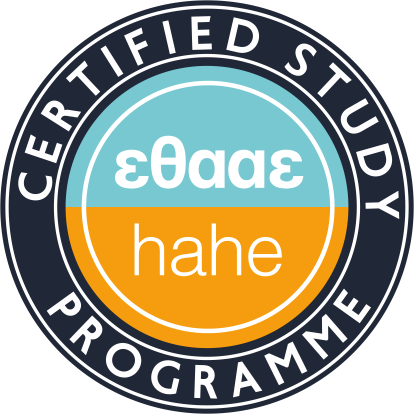Introduction to Digital Transformation and Information Systems
Teaching Staff: Kourouthanassis Panagiotis, Pateli Adamantia
Code: HY260
Course Type: Core Course
Course Level: Undergraduate
Course Language: Greek
Semester: 5th΄
ECTS: 5
Teaching Units: 3
Lecture Hours: 2
Lab/Tutorial Hours: 2L 2T
Total Hours: 6
Curricula: Revamped Curriculum in Informatics from 2025
The course Introduction to Digital Transformation and Information Systems aims to provide an understanding of the fundamental concepts of digital transformation and the role of information systems in modern organizational operations. Students explore the dimensions of an information system, its types and levels of application, as well as its lifecycle. Special emphasis is placed on software requirements gathering and modeling using techniques such as Data Flow Diagrams, User Scenarios, and User Journey Maps. The course combines theoretical knowledge with hands-on modeling exercises.
Upon completion of the course, students will be able to:
-
Understand the fundamental concepts of digital transformation and the role of information systems in enterprises.
-
Analyze the main dimensions of an information system, including technological, organizational, and human parameters.
-
Describe the different types and forms of information systems at tactical, managerial, and strategic levels.
-
Understand the importance of the lifecycle of an information system (IS Lifecycle Models).
-
Apply methods for collecting and documenting software requirements for information systems.
-
Use modeling techniques for functional requirements, such as Data Flow Diagrams (DFDs), Program Structure Diagrams, User Scenarios, State Transition Diagrams, Input-Process-Output (IPO) diagrams, and User Journey Maps.
Week 1: Digital Transformation – Basic Concepts & Strategies
-
Definition and significance of Digital Transformation
-
Key digital transformation models
-
The role of technology in changing business models
-
Examples of successful digital transformation cases
Week 2: Information Systems and Their Role in Digital Transformation
-
What is an Information System (IS)
-
Structure of an information system: Hardware, Software, Data, Processes, People
-
Linking information systems with business strategies
Week 3: Classification of Information Systems at Tactical, Managerial, and Strategic Levels
-
Operational Information Systems: Production Management Systems, Customer Relationship Management (CRM) Systems
-
Management Information Systems: Decision Support Systems (DSS), Business Intelligence systems
-
Strategic Information Systems: Big Data Analytics, AI-driven IS
Week 4: Information System Lifecycle Models (IS Lifecycle Models)
-
Waterfall Model, Prototyping Model, Agile & Scrum in IS development, DevOps and Continuous Integration/Deployment (CI/CD)
Week 5: Requirements Gathering and Analysis for Information Systems
-
Requirements elicitation techniques: Interviews & Questionnaires, Workshops & Brainstorming Sessions, Analysis of existing systems
-
Documenting and prioritizing functional and non-functional requirements
Week 6: User Scenarios and Requirements Description
-
Creation of user scenarios and identification of personas
-
Mapping user scenarios to software requirements
Week 7: Data Flow Diagrams (DFD) – Theoretical Background & Basic Concepts
-
What is a Data Flow Diagram (DFD) and how it is used
-
Elements of DFD: Processes, Data, Entities, Data Stores
-
Level 0 and Level 1 diagrams
-
Examples and analysis of real processes
Week 8: Data Flow Diagrams (DFD) – Application & Subsystem Analysis
-
Development of Level 2 DFDs and subsystem analysis
-
Linking DFDs with business processes
-
Case study: Creating a DFD for an information system
Week 9: Program Structure Diagrams
-
Decomposing software functionality into subsystems
-
Transition from DFD to Program Structure Diagram
-
Analysis of inputs, outputs, and processes per program unit
-
Problem-solving exercises
Week 10: State Transition Diagrams
-
Theoretical principles of designing state transition diagrams
-
Applications in systems with discrete states (e.g., e-commerce, banking systems)
-
Examples and exercises
Week 11: User Journey Maps
-
Theoretical principles of designing user journey maps
-
Using User Journey Maps to improve User Experience (UX)
Week 12: Object-Oriented Information System Modeling
-
Introduction to UML modeling techniques
-
Brief introduction to Use Cases and Class Diagrams
-
Choosing the appropriate technique for each case
-
Business application examples
Week 13: Review & Conclusions
-
Information Systems Development – David Avison, Guy Fitzgerald – Εκδόσεις Νέων Τεχνολογιών ΙΚΕ, 2017
-
Information Systems, 10th Edition – Joseph Valacich, Joey George – Εκδόσεις Τζιόλα, 2025
-
Information Technology for Management – Efraim Turban, Carol Pollard, Gregory Wood – Εκδόσεις Δίσιγμα ΙΚΕ, 2024
-
Theoretical lectures on course topics in class
-
Practical lectures and hands-on exercises in class
-
Learning process supported through the e-class platform
-
Use of application software relevant to the course
-
Written exam on course material
-
Group project related to course topics
Back
Studies
e-mail: cs@ionio.gr




 call for applications 2025-26 (v2)
call for applications 2025-26 (v2)